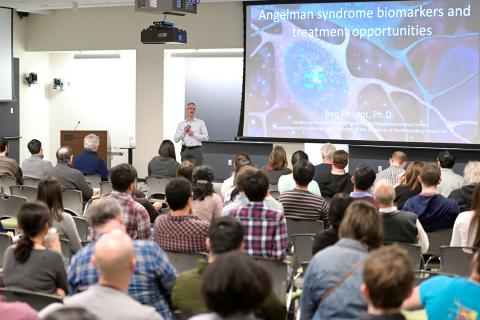Treatment Opportunities Seen for Angelman Syndrome

Photo: Marleen Van Den Neste
They may have the cheerful faces and demeanor of cherubs, but people with Angelman syndrome (AS), a rare neurodevelopmental disorder, also face significant lifelong challenges, including seizures, problems with balance and movement, and an inability to speak.
“We’re interested in developing a treatment for AS first and foremost due to the personal tragedy of the disorder,” said longtime grantee Dr. Ben Philpot at a recent NIH Neuroscience Seminar Series lecture. “We want to help these individuals who are so wonderful yet so challenged in life, and to help their caregivers. We’re also motivated because of this incredible opportunity for developing therapeutics.”
Kenan distinguished professor at the University of North Carolina, Chapel Hill, and associate director of the UNC Neuroscience Center, Philpot outlined his group’s promising potential treatments and clinical biomarkers for the syndrome.
“A hallmark of Ben’s research is that he likes to integrate genetic, electrophysiological, neurochemical and behavioral experiments to try to get a more holistic view of these animal models and also their translational potential,” said Dr. Andres Buonanno, senior investigator in NICHD’s section on molecular neurobiology, who invited Philpot and introduced the lecture.
In 1965, Dr. Harry Angelman, a British pediatrician, first described children showing symptoms of the condition that would later be named for him. Photos of Angelman patients often show them smiling and laughing, Philpot said. They typically demonstrate happy dispositions as well as severe intellectual disability.
“A very defining feature is their lack of speech,” he explained. “Individuals often don’t speak a single word their entire lifetime, yet they can live a full life.”
Approximately 90 percent of people with AS experience frequent seizures, about 80-90 percent have microcephaly (small head circumference leading to poor brain development), 80 percent have rhythmic EEG patterns and about 75 percent have sleep problems.
A single-gene disorder, AS results from deletions or mutations of the gene UBE3A. The syndrome has a high comorbidity with autism and occurs in about 1 in 15,000 individuals.
“Neurotypically, UBE3A is only expressed off the allele we inherit from our mothers,” Philpot explained. “The paternal allele is epigenetically silent. In Angelman syndrome, however, the maternal allele has also been silenced due to mutation.”
In their studies, Philpot and colleagues use mice genetically modeled with AS. The animals mimic key features of the disorder in humans, such as learning and memory impairments, ataxia and increased susceptibility to seizures.

Photo: Marleen Van Den Neste
“There’s an incredible burden on this patient population,” said Philpot, describing the 60 percent of patients who exhibit multiple seizure types.
Currently, scientists are developing three strategies to treat the disorder—relieve symptoms, reactivate the dormant UBE3A or apply traditional gene therapy.
In efforts to relieve a major symptom—seizures, for example—doctors use anti-epileptic medications, nutritional interventions such as ketogenic or low-glycemic-index diets, and, in rare circumstances, surgery.
The full spectrum of anti-epileptics has varying degrees of efficacy and utility, Philpot said.
“Even with all of these anti-epileptics at our disposal,” he noted, “many of these individuals are refractory to the traditional anti-epileptics, so we need yet another line of treatment for seizures in individuals with Angelman syndrome.”
One promising new therapeutic for Angelman seizures is cannabidiol (CBD), the non-psychoactive substance Philpot jokingly referred to as a “hippie’s disappointment.”
Using synthetic CBD, which is about 99 percent pure, Philpot’s group has shown reduced seizure duration and severity in AS mice.
“This is the first hint that cannabidiol might lead to some therapeutic benefit for seizures [in humans],” he said, cautioning that safety and efficacy tests need to be performed first in clinical trials before any firm conclusions can be drawn.
“A much more transformative treatment would be to treat the disorder at its genetic core,” Philpot said, explaining his group’s efforts to reactivate the silent UBE3A gene.
“We were able to show that a drug, Topotecan, can very powerfully turn on the paternal allele of UBE3A,” he said. “This is really exciting because it’s an FDA-approved compound, so it was already cleared for safety and use.”
The drug worked both in vivo and in vitro in mice for up to a year after injection.
Still, Philpot said, researchers’ excitement has been tempered by several serious limitations: Topotecan comes with some toxicity, including the neutropenia commonly associated with chemotherapy. They also do not yet know how long the compound remains effective in the cortex.

Photo: Marleen Van Den Neste
Researchers have identified other small molecule compounds that they can deliver peripherally—and less invasively—but with similar gene-reactivating effects on AS mice. Further study is necessary.
Philpot also emphasized the need to develop acceptable measurements—biomarkers—for use in human clinical trials.
“People have had ideas of what to use for therapies before they’re actually ready to go to the clinic, before there were good outcome measurements,” he pointed out.
Philpot suggested several features he’d want in an ideal AS biomarker: clinically relevant, objectively quantifiable, minimally invasive, highly penetrant and reversible in the mouse model.
To evaluate one potential measuring tool, he and colleagues began analyzing enormous amounts of EEG data from AS patients and comparing the data with results from mice models. The scientists looked at delta waves and sleep spindles, or bursts of neural activity in the central nervous system .
“We’re really just beginning to scratch the surface about what types of information we can get from the EEG biomarkers,” Philpot said.
He ended his slide set with an animation he called “the ‘I Have a Dream’ portion of the talk,” showing an illustration of unhealthy mutated UBE3A genes, depicted as gray.
“The dream is we’re going to treat [AS] with a small molecule or some other type of therapy that could come in like a flurry of snowflakes and reactivate this dormant allele and make the neurons happy and healthy and pink and try to help these individuals with Angelman syndrome,” he concluded. “That’s really what our ultimate goal is.”
NIH funders of Philpot’s research include NICHD, NIMH and NINDS.
